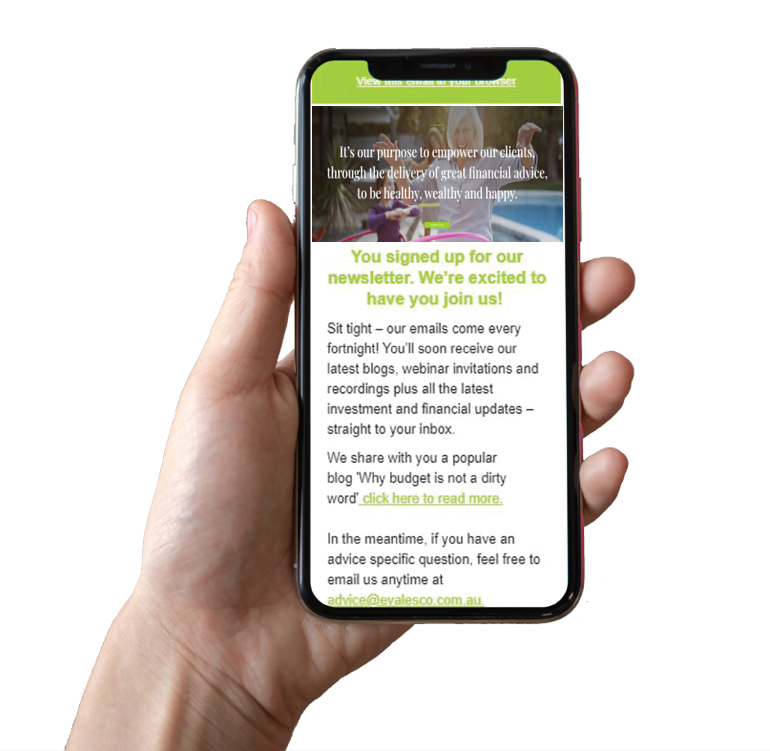Schedule a Chat
Contact Info
Suite 17.03, Level 17
20 Bond Street
Sydney NSW 2000

INSIGHTS WITH EVALESCO
TOPICS DISCUSSED
With yet another financial year about to end, it’s time to start getting everything in order for the 2022 End of Financial Year. It’s easy to push your EOFY tax planning duties aside, especially when our focus is still on COVID, but you don’t want to miss the opportunities that EOFY tax planning can present in terms of tax deductions.
Prior to 30 June 2022
Superannuation contributions
Maximise your superannuation deductions before 30 June 2022 by:
Downsizer superannuation contributions
If you are 65+ and meet the eligibility requirements* (see below for an excerpt of the ATO website) you can make a contribution to your superfund from the proceeds of selling your home of up to $300,000, without eating up your contributions cap or superannuation balance (and even if you have a total super balance greater than $1.6m). It’s a great opportunity to top up what you’ve saved in super if you haven’t had the chance (or if you’ve just been devoted to traversing Europe), and there’s no requirement to buy a new home if you’re planning on moving into your firstborn’s granny flat for some well-deserved pay-back free rent.
A couple of important factors to take into consideration:
An added bonus is that if the home that was sold was only owned by one spouse, the non-ownership spouse can also make a downsizer contribution (provided the other eligibility criteria* are met- see below for the list of criteria). All’s fair in love and real estate!
Additionally, there is a proposed change for downsizer superannuation contributions that will reduce the age requirement to 60+ instead of 65+. Speak to your trusted Morrows superannuation advisor today to learn more about the carried forward personal superannuation contributions threshold and the downsizer superannuation contributions scheme, and make sure you don’t miss out!
Immediate tax deduction for asset purchases
Take advantage of the immediate tax deduction available for depreciating assets acquired and first used by 30 June 2023, with no threshold limit on the cost of the asset. Small and medium businesses, with turnover less than $50 million, are also able to immediately write-off second-hand assets.
Small business tax concessions, available to businesses with turnover of $50 million or over
Tax concessions available to Small Businesses include:
Prepay interest on loans
Taxpayers who have borrowed money for investments can check with their lenders to see if they can prepay interest to gain an early tax-deduction by paying 12 months of interest in advance as a one-off tax benefit. This is an option for investment loans on properties, margin loans on shares and business loans.
Small business technology investment boost
Small businesses with less than $50 million annual turnover, will be able to deduct $1.20 for every $1 spent on business expenses and depreciating assets that support their digital adoption (such as portable payment devices, cyber security systems and subscriptions to cloud-based services). The boost applies to expenditure from 7.30pm 29 March 2022 until 30 June 2023 but will only be able to be claimed in the 2023 income tax return. An annual cap of $100,000 of expenditure applies, so those who expect to maximise their claim will benefit from spreading their expenditure between the 2022 & 2023 financial years.
Small business skills & training boost
Small businesses with less than $50 million annual turnover, will be able to deduct $1.20 for every $1 spent on external training courses for employees provided in Australia or online by registered training organisations. The boost applies to expenditure from 7.30 pm 29 March 2022 until 30 June 2024 but will only be able to be claimed in the 2023- and 2024-income tax returns. There is no cap on the amount of boost which can be claimed.
The Small Business Boosts were announced in the 2022 Federal Budget, however, are yet to be enacted. We will monitor for updates.
Capital gains tax (CGT)
If you have derived any capital gains from the sale of your investments or business assets this year, consider whether you can offset them by crystallising any capital losses on the sale of other assets (where possible), or be able to use the CGT Small Business concessions. Please contact us to discuss prior to 30 June 2022 to minimise or eliminate any potential CGT.
Private health insurance rebate changes
Private health insurance isn’t for everyone. It’s also a minefield understanding which fund would be best and working out the cover that you need, however it might be worth the effort because paying for private health insurance will save many Australians at tax time.
The federal government’s health system ‘rewards’ people for taking out private health insurance. If you reach a certain income level, the extra amount you pay in extra taxes towards public health will mean that private health cover is cheaper than the surcharges you’ll attract.
People earning $90,000 or more for singles, and $180,000 or more for couples are required to pay the Medicare Levy Surcharge at around 1 – 1.5% of their annual income.
Entitlements to the private health insurance rebate are income-tested, which means that if you have a higher income, your rebate entitlement may be reduced, or you may not be entitled to receive any rebate at all.
However, many private health funds set the rebate amount as a default at the highest rebate amount, and it is your responsibility to inform your private health insurer if you fall into a higher income bracket.
| Maximum Rebate/ No Surcharge | Tier 1 | Tier 2 | Tier 3 | |
| Singles | $90,000 or less | $90,001 – $105,000 | $105,001 – $140,000 | $140,001 + |
| Families | $180,000 or less | $180,001 – $210,000 | $210,001 – $280,000 | $280,001+ |
| Rebate under Age 65 | 24.608% | 16.405% | 8.202% | 0% |
| Rebate Age 65-69 | 28.710% | 20.507% | 12.303% | 0% |
| Rebate Age 70+ | 32.812% | 24.608% | 16.405% | 0% |
Note: The above rebate rates are subject to CPI adjustment each April.
The rebate entitlement is then checked within your income tax return each year, with any balance refunded or over-claim paid back to the Australian Taxation Office.
When you move into the next tier, the level of rebate and surcharge applicable will change. In view of these changes, consideration should be given as to the financial effect of private health insurance cover. The test is taken when your private health insurance is paid. If you believe you are going to move into the next tier in the next financial year, thought should be given into paying your health insurance premiums now; this will entitle you to your current level of rebate.
Division 293 tax on super contributions
Division 293 tax is an additional tax of 15% on concessional super contributions, if you earn over $250,000.
Income for the purposes of Div 293 tax includes
Concessional contributions include employer contributions, salary sacrifice, personal deductible contributions.
Company loss carry-back
A temporary tax relief allows eligible companies, with an aggregated turnover of less than $5 billion, to carry back tax losses incurred in the 2020 to 2023 financial years, to be used against profits taxed in a previous year, 2019 or later.
These companies will receive a refundable tax offset in the year they made a loss, if they elect to use this mechanism when they lodge their 2022-23 tax return. The losses carried back must not be more than earlier taxes profits and must not result in a franking account deficit.
Any tax losses that are not fully offset against previous taxed profits, or not elected to be used, will be carried forward as normal.
There are many good suggestions you can consider for your taxes in 2022. But, figuring out which of these are the right strategies for you can be challenging, and so we’re here to help. If you have any questions about tax planning speak to your adviser.
SHARE OUR INSIGHTS
Share on Facebook
Share on Email
Share on Linkedin

NEWSLETTER

Evalesco Financial Services Level 17, 20 Bond Street Sydney NSW 2000
Phone: (02) 9232 6800
The information provided on and made available through this website does not constitute financial product advice. The information is of a general nature only and does not take into account your individual objectives, financial situation or needs. It should not be used, relied upon, or treated as a substitute for specific professional advice. We recommend that you obtain your own independent professional advice before making any decision in relation to your particular requirements or circumstances. Evalesco Financial Services do not warrant the accuracy, completeness or currency of the information provided on and made available through this website. Past performance of any product discussed on this website is not indicative of future performance. Copyright © 2019 Evalesco Financial Services. All rights reserved